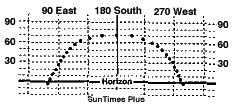 Hands On Physics
Hands On Physics
Haze
Core Project
Calibrating the Sun Photometer
Overview:
Now it is time to calibrate the instrument. When your Sun Photometer is
successfully calibrated, you ready to compare the information about HAZE
which you collect with the information collected by others. You can now
add your scientific observations to the HAZE data bank.
QUICK START! You can begin using your Sun Photometer
immediately without calibrating it. Just remember to record your measurements
and the date and time you made them in your notebook. But eventually you
must calibrate the instrument. You can then insert all the data you previously
collected into your calibration formula.
Calibrating the Sun Photometer:
Calibration Supplies
- Your Sun Photometer (completely assembled and working)
- Digital voltmeter
- Digital watch or clock
- Method for measuring the Sun's angle (see separate section)
- Notebook and a pen or pencil
- Sunglasses, a hat and possibly sun screen
- Linear graph paper
- Digital calculator with natural logarithm (ln) and sine (sin) keys
..or.. a computer with spreadsheet software
- Comfortable, safe place to sit while making measurements
- Cold drinks and snacks
An Important Note About Sun Safety... You'll need to spend up to
half a day in the Sun to calibrate the TERC VHS-1. Half a day in the Sun
can cause fair-skinned people to get a sun burn, so be sure to wear long
sleeves and rub sun screen on exposed skin if you are susceptible. No matter
what shade or color your skin is, be sure to wear a hat and sunglasses to
protect your eyes from the ultraviolet radiation (UV-B) scattered from the
sky. Skin color doesn't matter when it comes to protecting your eyes from
dangerous UV-B!
WARNING: AVOID DAMAGE TO YOUR EYES! NEVER LOOK AT THE
SUN, EVEN WHILE WEARING SUNGLASSES! ALWAYS WEAR SUNGLASSES WHEN LOOKING
AT THE SKY!
Calibration Procedure
WARNING: ALWAYS WEAR SUNGLASSES WHEN LOOKING AT THE SKY!
NEVER LOOK DIRECTLY AT THE SUN EVEN IF YOU ARE WEARING SUNGLASSES!
- Switch the Sun Photometer switch to the ON position, press the Sun
port on the instrument against a dark object (black paper or your clothing)
and write the number displayed by the voltmeter in the third of four columns
in your notebook. This number is known as your instrument's dark signal.
You must measure it each time you measure the Sun.
Carefully point the VHS-1 at the Sun by centering the bright circle of light
that passes through the upper angle bracket directly over the Sun target.
While holding the VHS-1 as steady as possible, read the voltage indicated
on the voltmeter. The numbers on the voltmeter display will flicker up and
down. For best results, pick the highest number that appears when the unit
is pointed directly at the Sun. This number is called the Sun signal. Write
the Sun signal in the third column in your notebook and the exact time in
the first column. Here is a sample notebook entry for the prototype TERC
VHS-1 from 17 March 1996. Time Dark Sun Sky
012:47:40 0.235 3.12 Clear
- If you plan to determine the Sun's angle using one of the manual
methods described in Concepts
, try to make your Sun angle and VHS-1 measurements as close together as
possible. Ideally, one student should make the VHS-1 measurements and another
the Sun angle measurements while a third student records the data in the
notebook.
- Space your measurements 15-20 minutes apart when the Sun is high
in the sky. As the Sun rises (or descends), make the observations more frequently.

Figure C5
The Sun's Angle
- The Sun's angle over the horizon changes much faster in the early
morning and late afternoon than at midday.
PLAN AHEAD! Before its time to increase the number of
measurements, be sure you have something to drink and maybe some snacks.
Use the rest room before beginning your rapid series; there won't be time
during the actual measurements!
Previous Page || Up
a Level || Index || Next
Page